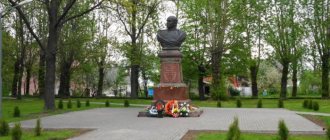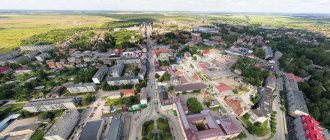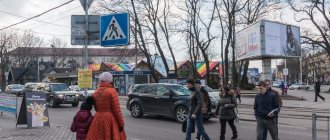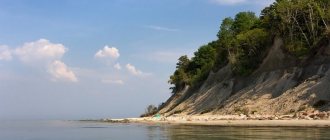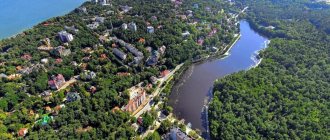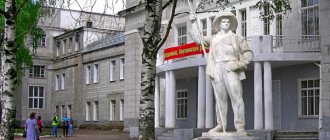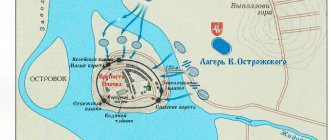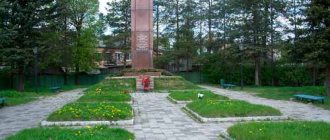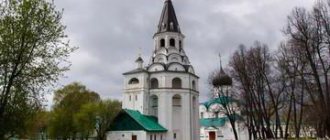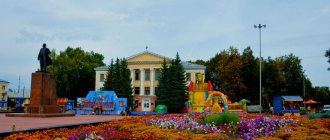Mysterious places
Here you will see truly unique places, the very name of which attracts with its mystery. This:
- Dancing Forest;
- Muller height;
- Dune Efa;
- Fishing village;
- Ancient castles, as well as many other equally fascinating attractions.
Most interesting places can be visited by car or joined one of the excursion programs. No matter which method you choose, you will have a truly unforgettable experience. But it takes a lot of time to see all the interesting sights of this region. Therefore, you should carefully study them to create your own excursion program.
So, what attractions of the Kaliningrad region should you visit first?
Curonian Spit
It stretches all the way to the border with Lithuania, dividing the Curonian Lagoon with fresh water and the Baltic Sea. The territory of this sandy coast, which is 400 m wide and 4 km long, belongs to two countries. This is a favorite vacation spot for tourists who are attracted by the unique nature of the area. The amazing combination of sand dunes, forests and meadows brings thousands of people here every year, who get the opportunity to swim in the fresh water of the Curonian Lagoon and the salty sea in one day.
There is also a national park here, where, thanks to the unique microclimate, you can find a huge variety of flora and fauna. In order for tourists to see everything they have planned, special walking paths have been created here along different routes that cover the entire territory of the reserve. This park is the very first to be founded in Russia, as well as the smallest. Despite its modest size, it offers guests a lot of entertainment: creativity competitions, charity events and various conferences are regularly held here.
Dancing Forest
This is a unique place, which is located on the Curonian strip. Walking through the small local pine forest, you will notice that the trees twist at the most incredible angles. There is a belief that here you need to walk only on special walking paths, otherwise the trees will take you to themselves. You should also not pick off their leaves, bark, or even the grass of the area.
The question of why pine trees, which always grow only straight, suddenly began to twist in this way, has still not found a scientifically proven answer. There are a variety of versions, including even alien intervention. The forest is located on the road leading to Lithuania, and you can get here either by your own car or by public transport or taxi.
Muller height
This is the name of the highest point of the largest dune of the Curonian Spit. It is named after the forester who, thanks to hard work, was able to stop the movement of the sands. With this he saved the nearby village of Rybatsky.
Now this is a place where many tourists go every year. There is a convenient path for them, along which you can enjoy the magnificent air and beautiful views of the spit. The entire road stretches 2 km, the amount of time spent will depend on how often you stop for filming. From Muller Heights you will have a magnificent view of the sea, the bay and the rescued village itself.
Dune Efa
This is the highest dune not only in the bay, but in all of Europe. You can get to its top along a wooden deck. Independent movement along the dune is strictly prohibited, but you can enjoy the beautiful panorama from one of two observation platforms.
Due to such a number of not only beautiful, but also unusual, unique places, every tourist who comes to the Kaliningrad region is worth a trip to the Curonian Lagoon.
Zelenogradsk
We recommend that you definitely see this city in the Kaliningrad region. The Kaliningraders themselves are simply in love with him! The resort is located only 9 km from the Curonian Spit. The former Kranz is famous for its long, well-maintained promenade, along which it is pleasant to walk along the sea. Zelenogradsk is considered the birthplace of Pinocchio, so it is interesting to visit this city with children. Adults are curious to see the Krell Villa and Queen Louise's pump room, and children are curious to look at the cute Murarium cat museum.
From Kaliningrad to Zelenogradsk it is only 32 km, so you can go for just a day - the journey by regular bus or train takes less than an hour. We recommend going with a guide: there are family quest excursions and individual trips with a stop at the Curonian Spit.
Find out about holidays in Zelenogradsk.
Along the beaches of Zelenogradsk, above the sea line, there is a promenade. Photo: ph1l74 / flickr.com / CC BY-SA 2.0.
Monuments of Kaliningrad
Over the course of its long history, the city has erected many different monuments to historical figures. However, among them there are several monumental creations that you simply must see.
Triumphal Column
Address: Victory Square. Transport stop "Victory Square".
The column, installed to celebrate the 750th anniversary of Kaliningrad in 2005, became not only the architectural dominant of Victory Square, but also one of the symbols of the city. True, it acquired its final form only 8 years later. Then a huge granite Order of Victory was placed on top of the 26-meter monument. The column is placed on a tetrahedral pedestal, the sides of which are decorated with bas-reliefs telling about the glorious victories of Russian weapons. They depict Napoleon's Cossacks crushing soldiers, fragments of the Seven Years' War, the Great Patriotic War and World War I.
Monument to the Conquerors of the Near Universe
Address: Mira Avenue. Transport stop "Zarya Cinema".
It was no coincidence that the monument to the explorers of outer space appeared in the city. The Kaliningrad region gave the country a whole galaxy of cosmonauts - Alexei Leonov, who became the first person to walk into outer space, Yuri Romanenko and Viktor Patsayev, who tragically died during the landing of the descent module of the Soyuz-11 spacecraft. On the four-step terrace there is a pedestal on which is mounted a ring symbolizing the earth's orbit, with the figure of an astronaut inside. Plates with bas-reliefs of space pioneers are mounted on the sides of the pedestal. The author of the monument, erected in 1980, is the famous sculptor Edunov.
Wrestling bison
Address: Mira Avenue, 1. Transport stop "Technical University".
One of the oldest monuments in Kaliningrad, which appeared in its place in 1912, is loved by citizens and popular with tourists. The author of the composition depicting two bulls grappling in a fierce fight, cast in bronze in life-size, is one of the most famous animal sculptors of the early last century, August Gual. The animal figures are made with amazing precision. Their tense muscles and swollen veins are clearly visible. The sculpture is placed on a stone pedestal in front of a small pool. Streams of water and figured rosettes placed at the base of the monument flow into it.
This article describes only some of the sights of Kaliningrad. Be sure to visit this wonderful city and be sure that it will certainly enchant you.
Architectural sights of Kaliningrad
Kaliningrad has architectural buildings that have their own history, value and are marked on the map of the city's attractions:
Royal Gate
This is one of the 7 gates built in Kaliningrad. Construction of the structure began in the 19th century. Initially, the purpose of construction was to defend the city. But their mission did not last long. The Royal Gate began to be considered a city landmark, and one of the most interesting.
They are located on Frunze Street, 112. There are bus stops near the attraction. To get to the Royal Gate, you need to get off at the Litovsky Val stop. From there there are nine buses to your destination. Arriving at the museum, you can see a wide passage, near which there are casemates. Also on the gate are portraits of famous kings and family coats of arms.
Villa Schmidt
It is considered an architectural decoration of the city. It was built in 1903 and bears the name of its first owner. The villa was built in a romantic style, which was characteristic of the 19th-20th centuries. Villa Schmidt has survived to this day in its original state.
It is located at the address: Pobedy Avenue, 24. You need to take public transport either at the M. Gvardiya stop or at Brusnichnaya. Take bus No. 24 to Pobeda Avenue and walk to Kindergarten No. 27.
Police Presidium building
The building was built in 1912. Until 1945, the political police of the Third Reich (Gestapo) were located on this site. Before the collapse of the USSR, the KGB was located in the building. The construction was done in the neo-Renaissance style. A distinctive feature of the style is the desire for symmetry, rectangular shapes with courtyards, balconies with terraces.
Also at the entrance to the building itself there are shell rock reliefs made by a famous sculptor. Located at Sovetsky Prospekt 3-5. You can get there by trolleybus No. 1, which departs from the Chkalovsky turn. Or by bus number 4, also to Tchaikovsky. The bus leaves from the Yantar Factory.
Rossgarten Gate
This is also one of the 7 gates built in Kaliningrad. They were built in 1855 as a decorative structure, but the gates were also supposed to serve a defensive function. The project was created by a famous engineer-lieutenant. During the war they were badly damaged, but they were restored.
The work of the sculptor gave the structure lightness. This is usually not typical for such structures. At the Rossgarten Gate one can observe sophistication and grace. Now this place is occupied by a restaurant. Address: Chernyakhovsky street. You can get there by taking buses from the Vasilevsky Square stop. More than 20 buses go there.
House of Soviets
A popular building that has been under construction since 1970 and is still unfinished. It is considered an unofficial symbol of Kaliningrad. The architect planned a building 28 floors high. The area around the building was planned to be beautifully arranged. But, since the soil in this place is unstable, problems arose.
Therefore, only the 21st floor was built. In the second half of the 80s. construction was stopped, but by that time the building was almost completed. In 2005, renovations were carried out, and the building began to look more modern.
But even now it is still unknown what awaits this building. Located at Shevchenko Street, 8. How to get there by transport: you need to find Stanochnaya Street and head towards Moskovsky Prospekt.
Svetlogorsk is a famous resort throughout Russia
In Svetlogorsk you can not only improve your health and engage in recreational tourism. The city is worth visiting for the beautiful sights. One of these is the Church of Seraphim of Sarov. Previously it was a church, now the building serves the Orthodox Church. The architectural style clearly indicates Lutheran origins. Architecturally, the building combines:
- neo-Gothic;
- modern;
- Lutheran classics.
Inside, the interior was created according to the plans of the German architect Goering. He personally donated money to the temple for improvement. The Temple of Seraphim of Sarov is one of the rare examples of religious buildings that have survived in the Kaliningrad region, despite the raging war.
Of no less interest to tourists is the water tower, which can easily be included in the TOP of the most famous engineering structures in Europe. The water tower is unique in that it represents the Prussian style. It is considered the most amazing and complex of all that were built in East Prussia.
The history of the chapel of the Icon of the Mother of God glorified this seemingly unremarkable structure. On May 16, 1972, an An-24 plane crashed and fell directly on a city kindergarten. There was a fuel leak and fire, only 2 people were able to survive the disaster. They learned about the sad event only 22 years later; city residents themselves donated money for the construction of the chapel. Now it houses a Sunday school. It's definitely worth taking a ride on the cable car. Small trailers with open windows allow you to see the beauty of nature. The elevator lift is a very romantic way to spend time.
To complete the excursion, the House-Museum of the sculptor Hermann Brachert is also worth a visit. The Bracherts lived in East Prussia. The sculptor initially devoted himself to medal sculpture, sculpture and jewelry making. He created 20 sculptures for Königsberg. The master taught at the school of arts and crafts, then moved to Stuttgart. The Bracherts' merit lies in preserving valuable materials of cultural significance and telling about the peculiarities of life in East Prussia.
Option No. 2
Kaliningrad is a city located in the Kaliningrad region, formerly called Königsberg. Population: 482,443 people. What is unique about the Kaliningrad region is that it does not have a border with the Russian Federation. The neighbors of the Kaliningrad region are Poland and Lithuania.
Climate and ecology
The weather in Kaliningrad is unstable due to the maritime continental climate. This is due to the fact that the enclave is washed by the Baltic Sea. There are no low temperatures in winter; on average it is -5 degrees. In summer there is little precipitation, mostly there are many sunny days.
The ecological situation in the city is bad. In 2013, in the ranking of 100 Russian cities in terms of air pollution, Kaliningrad was in the middle of the list. The air is mostly polluted due to the large number of cars and narrow streets.
Transport
There are many roads in Kaliningrad, and motor transport is also common. In addition, there is an airport here, which is the first civilian airport, and an ice-free port on the Baltic Sea. There are railway stations in the city and there is a bus service between the cities.
Culture
There are 21 universities in Kaliningrad, 6 of which are state-owned. There are also many museums in the city. The oldest is the Kaliningrad Regional History and Art Museum; it was founded in 1946. There are 6 theaters in Kaliningrad, and a variety of musical performances are held annually. There are also many libraries and cinemas in the city.
Interesting Facts
- The philosopher Immanuel Kant was born and lived in Königsberg.
- One of the symbols of the city is the amber museum in a red brick tower.
- The city was named Kaliningrad in honor of Mikhail Ivanovich Kalinin, who was a Soviet party leader.
The most famous sweet in the city of Kaliningrad is marzipan.
Slavsk is a city for recreational holidays
Slavsk is known in the Kaliningrad region as a city with a swimming pool containing mineral water. It was built back in 1936. The pool underwent reconstruction in the 1960s. The benefits of Slavic mineral water have been proven by scientists.
After visiting the pool, you can immediately go to the church, the construction of which dates back to the end of the 17th century. Previously, it was small, but since there were many parishioners, it was decided to expand it. It is noteworthy that the temple was originally a wooden building. The neo-Gothic style is close to all of Slavsk, and the church is its original pearl. The altar and its font were originally made of red sandstone. A memorable place is the war memorial, where the remains of those who died as a result of serious injuries during the Second World War are located. 389 names of the fighting soldiers and officers are written on the marble memorial plaques.
The beauty of Slavsk is revealed in its simplicity and well-groomed conditions. It is a striking example of how small towns can look in modern Russia if the development in them is approached with taste. Vivid evidence of this is the children's music school and the miniature Orthodox church.
Fishing village
Literally a stone's throw from the cathedral there is a quarter called the Fishing Village. There used to be a shopping street here where fish were actually sold. Now there is a picturesque tourist quarter, the buildings of which include hotels, cafes and, most interestingly, a lighthouse.
What's interestnig:
— you can pop into a cozy cafe on the second floor of the lighthouse to drink a mug of good coffee and admire the view; — there is also a wine tasting and an exhibition of paintings; — at the very top of the lighthouse there is a magnificent observation deck, and you can book this place for a romantic evening dinner, for example; — in addition to the lighthouse, you can stroll along the magnificent embankment; — there is a shop of amber products in the block.
Where is
It is a 3-minute walk from Königsberg Cathedral, open the map in a new window.
Amber Museum in Kaliningrad
In order to take a breather after visiting all sorts of city attractions and visiting architectural monuments, you can take a break by visiting the Amber Museum. This is a fairly famous museum of the magic stone, popularly called Alatyr.
The Amber Museum opened in 79 of the last century. The neo-Gothic building in which it is located is a tower built in 1853. This museum is one of its kind in Russia.
The museum consists of 28 halls. The five museum sections present not only various amber samples, but also extensive information about the stone. Visitors will be able to learn the history of the appearance of amber, and how, where and when it was used.
The museum conducts scientific work and has its own publishing house. The museum hosts scientific biennials and lectures. The research achievements of scientists and their works are published in different languages.
Top 5 most beautiful cities in the Kaliningrad region
- Zelenogradsk A small resort town where you can enjoy walks and well-maintained streets.
- Slavsk A city with mineral springs.
- Svetlogorsk A famous resort in Russia and Ukraine, which has earned great respect from foreigners.
- Kaliningrad. The capital needs no introduction; many attractions are still preserved, although little of the atmosphere of the former Königsberg remains.
- Chernyakhovsk. The city will delight you with an equestrian castle and a castle of the same name.
Fishing village
The “Fish Village” will be a very interesting place to visit for tourists. Opened not so long ago - only nine years ago, this village is quite an interesting Kaliningrad attraction.
The complex consists of fourteen objects. The basis of the complex is the restored appearance of ancient Königsberg. The complex is represented by a variety of Gothic towers and authentic fish market architecture. Everything here - even small details - corresponds to past eras. In these places, tourists love to take photographs for memory.
There is also a river bridge across the river, famous for its history. Nowadays the bridge is a pedestrian bridge and is considered the most romantic place in the city.
Boat rides are organized along Pregol. Riding along the river, one way or another, you become saturated with the spirit of the past Prussian city. And if you climb the Mayak tower, which is located here, you can see the panoramic beauty of the city.
Interesting places in Kaliningrad
The list of Kaliningrad attractions will take more than one page. It will take several days to visit all the interesting places. It is best to come to the city for 5-7 days.
Fishing village
Fishing village in Kaliningrad
During the Second World War the city was bombed. The historical center was destroyed. In Soviet times, no attention was paid to the issue of restoring historical buildings. The Fishing Village is an attempt to reconstruct the lost appearance of Königsberg. In 2007, several buildings in traditional German style were erected. They housed souvenir shops, jewelry stores, restaurants, and hotels. The lighthouse stands out among them; there is an observation deck on it. Be sure to climb up the narrow spiral staircase to admire the city from above.
Amalienau
Amalienau
When tourists walk around Kaliningrad, they most often see Soviet buildings. And typical German architecture is represented by small islands. The Amalienau region is one of them. At the beginning of the 20th century, construction of a new district began in the suburbs of Königsberg. It was built primarily for wealthy people. Two-story villas with a garden, panoramic windows and large green areas were to become the basis of Amalienau. Unfortunately, the two world wars changed these plans and the area was never fully developed. And you can admire what remains today. Don't miss the red brick Villa Schmidt, built in Art Nouveau style.
Kaliningrad Zoo
Kaliningrad Zoo
Kaliningrad is home to one of the oldest zoos in Russia. It was opened at the end of the 19th century, when the city was called Königsberg. In 1946, the general condition of the zoo could be assessed as deplorable: most of the animals died during the war, the enclosures and administrative buildings were in disrepair. Through the efforts of the Soviet government, the zoo was restored and today both city residents and tourists love to come here. Almost 2,500 animals (300 species) live on an area of 16.5 hectares. A favorite pastime of visitors is watching demonstration feedings. You can watch bears, turtles, crocodiles, seals, elephants and giraffes eat.
Königsberg Castle
Königsberg Castle
The castle was founded by the Knights of the Teutonic Order in the 13th century. At first the structure was wooden, and then it was replaced with stone. The site for the construction of the castle was chosen on the high bank of the Pregolya River. Along with the Cathedral, Königsberg Castle is the oldest landmark of the city. The tallest structure was the Castle Tower, its height was 85 meters. Along with several towers, the castle housed a reception hall, the Castle Church, a library, a wine restaurant and living quarters. Unfortunately, this landmark was lost during Soviet times, when local authorities decided to demolish the castle and build the House of Soviets on this site. Now only ruins remain of the castle, archaeological excavations are not being carried out and the issue of restoring the historical building has not been resolved. Today you can go to the observation deck and look at the ruins of the once majestic castle of the Knights of the Teutonic Order.
Kaliningrad
I would advise setting aside 2-3 days for the city. During this time, you can see all the main attractions of Kaliningrad on your own or with excursions.
Where to stay
We lived in the RiverSide 3* hotel. It stands on the Pregolya embankment, but not in the center. Overall, I really liked it: the service is good, you can see the new stadium from the window, the grounds and rooms are excellent.
If you want to stay in the center so that it is convenient to see the main attractions, I advise you to consider the hotels “Europe”, “Kaliningrad”, “Kaiserhof”.
Where to eat
I can recommend places where you can try Baltic cuisine, local fish, or just dine on homemade dishes:
- Aunt Fisher . German restaurant with a cool atmosphere. Try smoked meats, fish quiche, homemade sausages and strudel.
- Hops . The restaurant is popular, so you may not be able to get there during peak hours. They have their own brewery. Nourishing, tasty, atmospheric.
- Peppers . For “tasty and inexpensive” food in Kaliningrad, you should go here. From 11 a.m. to 4 p.m., you can take a business lunch for up to 300 rubles. Other restaurants also offer set lunches, but I liked the large selection of dishes at Pertsy.
Be sure to have a snack at the Konigsbaker chain establishments - they have delicious buns, pies, and cakes (they operate throughout the region). I really like their bagels, cheesecakes and quiches.
Day 1
We look at the center of Kaliningrad: the Fish Village complex, the embankment, Kant Island. If you love boats, take a walk along the Pregolya River. I liked this one: comfortable and with a cool route that captures as many of the sights of Kaliningrad as possible.
On the same day you can visit the Museum of the World Ocean. This is also on the embankment. If the theme doesn't interest you, just look at it from the outside, it's beautiful. Especially the new pavilion in the shape of planet Earth. In the evening you can listen to an organ concert in the Cathedral or drink beer in a German restaurant.
Day 2
Walk to the Church of the Holy Family. Visit the Marzipan Museum at the Brandenburg Gate (free admission). If you have any energy left, head towards the Amalienau residential area with beautiful German houses. Or stop by the Amber Museum and take a walk along the Upper Pond.
I wrote in detail about the most important attractions of Kaliningrad here.
Historical places
House of Kant
Address: st. Zelenaya, 23, Veselovka villagePhone: 8 (401) 299-49-00Coordinates: 54.590282, 22.032166How to get from Kaliningrad: 105 km to Veselovka village in the direction of Chernyakhovsk
The philosopher I. Kant lived and worked as a teacher in this house in the 18th century. The house contains exhibits telling about the life and works of the philosopher.
The restorers managed to recreate the interior of the living quarters and the smokehouse.
Castle Saken (Schaaken)
The castle is located 40 km from Kaliningrad. It was first mentioned in the Order Chronicles in the 13th century. After the expulsion of the owner, the Order garrison was stationed there. Its goal was to defend the coast of the Curonian Lagoon.
A craft town gradually grew around the castle, and a church was built. Today the names of 21 order knights are known, who ruled the castle at different times. Peter I stayed here several times with Catherine.
By the beginning of the 20th century. Shaaken was partially destroyed. Today, on its territory, tourists participate in knightly competitions, watch fire shows, ride horses, etc.
Insterburg Castle
Address: Chernyakhovsk Opening hours: 10.00-20.00, closed on Monday Telephone Coordinates: 54.640296, 21.806149 How to get there: 90 km by car or by bus to Chernyakhovsk
Knight's castle 14th century. named after the city of Insterburg (Chernyakhovsk), in which it is located. It was built by the Master of the Teutonic Order as a defensive structure on the route of the Lithuanian troops and the bastion. The building is made of natural stone and medieval baked brick. Defensive walls with watchtowers extend from the central part of the castle.
The castle is badly damaged. Tourists come here to see visiting museum compositions and take part in art festivals.
Brandenburg Castle
Address: Ushakovo village, st. Pobeda, 1aPhone: 8-950-67-67-355Ticket price: from 50 rublesCoordinates: 54.614766, 20.248678How to get there: 25 km by car or by bus to Ushakovo
Currently, the castle is the ruins of once powerful walls with ceilings. The castle was built as a defensive structure during the time of the Teutonic Order in the town of Brandenburg (Ushakovo village) on the shore of the bay. In the 15th-17th centuries. in this place there was a large settlement, numbering several dozen households, and taverns.
The castle was badly damaged during the Second World War. In summer, theatrical performances are held on site.
Ragnit Castle
Address: Neman, st. Pobedy, 47Coordinates: 55.039365, 22.030005How to get there: 130 km by car or bus to Neman
The ruins of the Ragnit castle are located in the city of Neman (until 1947 Ragnit). This is the largest and one of the oldest castles in the region - 13th century.
It served as an outpost in the north of the Teutonic Order. Over the several centuries of its history, the castle burned several times and experienced numerous sieges. At different times it served as a citadel, a court, and a prison.
The castle needs restoration.
Gross-Wonsdorf
Address: Kurortnoye village Coordinates: 54.468387, 21.123463 How to get there: 65 km from Kaliningrad in the direction of Pravdinsk, then 3 km in the direction of Lugovoe village
The settlement was first mentioned in historical documents in 1256. Until 1928, the village was called Gross-Wonsdorf, and until 1950 - Wonsdorf. Now it is called Kurortnoe village.
The castle was founded by the order in the 14th century. for defense. A dam was erected next to it and a mill was built.
From the 18th century until 1945, the castle belonged to the von Schrötter family. Members of the respected family held the positions of ministers and chancellors of the Kingdom of Prussia. I. Kant was a great friend of the family; he often visited the castle.
Today, the ruins of the gate tower, small fragments of walls and the remains of the fortress rampart have been preserved. The park on the site of the forburg is neglected, the entire area is overgrown with trees and bushes. The stable building of the von Schrötter estate is the best preserved building. The castle needs restoration.
Monuments
List of famous monuments that may be of interest to tourists, with a brief description:
- The monument to Duke Albrecht was erected in 1891 next to the Cathedral.
- Monument to soldiers - internationalists. Located in Yunost Park. It was opened in 1998.
- The monument to Hermann Klaass was built in 1913. Dedicated to the founder of the zoo.
- Monument to Julius Rupp. Dedicated to a rebellious preacher who renounced the church and opened an evangelical community.
- The monument to Peter I is located at the headquarters of the Baltic Fleet. Dedicated to the founder of the Russian fleet.
- Monument to M.I. Kalinin, after whom the city was named, was created in 1946.
Chernyakhovsk - simple and at the same time unusual
The stud farm located in Chernyakhovsk is located next to the famous castle. The history of this place dates back to the 13th century. Then the Teutonic Order decided to build a castle, which was named after St. George. Every castle should have a stable, but the knights decided not to waste time on trifles and built many stables at once. At the beginning of the 19th century, merchant Johann Albert Heine decided to purchase and later resell the stud farm along with the castle. The fortress began to be used as a residential building. And, of course, the plant workers themselves lived in it. Until now, Georgenburg is considered one of the largest European stud farms. Its territory exceeds 2.5 hectares. The popularity of Chernyakhov breeds has gone far beyond the city. Now international competitions are regularly held here. As for the castle, it is literally enveloped in the aura of the Middle Ages. At first it was a wooden building surrounded by a moat. Towards the middle of the 14th century, construction of a stone castle began. The fortress was occupied by the Swedes twice. Only in the mid-18th century did they begin to breed horses. For some time, the castle even served as an infectious diseases hospital. It now belongs to the Russian Orthodox Church and is used as a tourist site.
Visit the Church of St. Bruno of Querfurt to appreciate the work of the architect Friedrich Heitmann. The temple appeared in 1863. Then the city was called Insterburg. Perestroika was carried out in 1865. For a long time, the temple fell into disrepair, and only in 1992, thanks to the Roman Catholic community, its restoration began. The church has a large organ and services are held regularly. A Franciscan monastery has been operating since 2005.
You can complete your tour of religious buildings at St. Michael's Cathedral. The temple has 3 naves, 2 towers and a high bell tower. Previously, dark brown brick was used as cladding. A characteristic feature was the presence of an organ. The war practically did not affect the church; for some period it served as a warehouse, then a club and even a gym. The building was empty for a long time and even survived a fire. The fire destroyed the pristine interior, almost destroying all the beauty. The Russian Orthodox Church, together with charitable organizations, restored the church. The restoration process has not yet been completed, but the iconostasis has already been restored, and the work of a spiritual and educational center is underway.
The beautiful cities of the Kaliningrad region are worth visiting. If you are going to discover the Baltic states, be sure to go first to the Kaliningrad region, because it holds an amazing history.
Zelenogradsk is an ideal city for walking
The most interesting landmark of the city is the Kranz water tower. This is his symbol, which is a real work of art. The tower was built in 1904; it became a prominent representative of historical eclecticism. Climbing up, you can appreciate the views of the city dotted with trees. The Murarium is also located here, a cat museum that children will definitely enjoy. The Transfiguration Cathedral, which was previously called the Church of St. Adalbert, is made of red brick. Its Gothic tower is clearly visible even from a long distance. The building was built under the direction of the architect Launir. At the end of World War II, the church was no longer a religious building. It came into the possession of the Russian Orthodox Church in 1994. And it was consecrated only 13 years later. The Chapel of St. Andrew will help you continue your tour of interesting sights. It is worth a visit for anyone who wants to see the work of carpenter Laufer, a renowned Königsberg master of his craft. In the church you can see the relics of the great holy Apostle Andrew the First-Called.
In the ranking of the most beautiful sights of the Kaliningrad region, Villa Krell will always occupy a special place. And all thanks to glazed tiles and a unique combination of architectural styles. In it, the architects combined Gothic and Russian styles. Now the villa is used as the Zelenograd Museum of Local Lore, and previously served as a notary firm. In the courtyard of the villa there is a curious sculpture “Prussian cat”. Legend has it that this cute creature holds the keys to all the gates of Kaliningrad. There are many more such pleasant little things to be found in the city, which is why it is so suitable for long walks.
A little history with geography
It owes its unique history to its geographical location. The Kaliningrad region is separated from “greater Russia” and borders Lithuania and Poland to the east and south, and is washed by the Baltic Sea in the west. The city was German, except for a short period under Elizabeth (18th century).
Only in 1945 did Koenigsberg and its surroundings become part of the Soviet Union. For another year it bore a name unusual for Russian ears and in 1946 it became Kaliningrad. During the period of Soviet power and in the post-Soviet years, much was lost that testified to the centuries-old European “biography”. But in the 21st century everything returns to normal. Now, in addition to restored architectural and historical landmarks, the city with a population of half a million can boast of an excellent hotel industry.
All this, coupled with a mild climate (affected by the proximity of the Gulf Stream) and picturesque nature (sea coast, a unique arboretum, the Pregel River with islands right on the city’s territory) makes Kaliningrad attractive to a large number of tourists from among Russians and European neighbors.
The city has two train stations and an international airport, which is important due to the need to cross borders when traveling overland. In general, Kaliningrad residents are trying to create all the conditions so that tourists want to come here more than once
Where to start getting to know the city?
Kaliningrad Cathedral
Kaliningrad Cathedral.
Photo: Mikhail Rudnitsky / photobank “Lori” The cathedral is located in the historical district of the city - on “Kant Island”. It was founded in the first third of the 14th century under the patronage of the Teutonic Order, and today it is one of the few examples of Gothic architecture in Russia.
The building was completed in 1380, but various details were added to it until the middle of the 17th century. In 1544, the Albertina University was opened opposite the temple, and the cathedral became the university church. Since 1558, a cemetery for professors appeared in the northern part of the altar - Immanuel Kant was the last to be buried here. Since 1650, one of the cathedral towers has become a repository for ancient books and manuscripts of the Wallenrod Library.
In August 1944, the cathedral was almost completely destroyed - only the walls stood. The building began to be restored in 1992. Today there is a museum on the territory of the Kaliningrad Cathedral. Its exposition contains a collection of coins and banknotes, and a wooden carved library. The cathedral has the largest organ complex in Europe.
Basic information
Story
It was founded on September 1, 1255. The beginning of the modern city was a castle erected on the site of the Prussian fortification of Twangste in the lower reaches of the Pregel River.
The founders are considered to be the Grand Master of the Teutonic Order Poppo von Osterna and the King of the Czech Republic Přemysl Otakar II. Tvangste was besieged by knights, but after help arrived from the king of the Czech Republic, the settlement fell. The first structure was made of wood, and in 1257 the construction of brick walls began.
The castle was named Königsberg ; it was besieged by Prussian tribes three times (in 1260, 1263 and 1273), but survived. In subsequent years, German colonists began to arrive to develop Prussian lands. The indigenous people were assimilated and by the 16th century only 20% of the total population remained.
You may also be interested in: “Koenigsberg City Gate: history, photo and description”
On February 28, 1286, the settlement near the castle walls, bearing the same name, was awarded city rights. Other settlements were rapidly growing around. In 1300, another city began to be called Löbenicht, where the first printing house was opened in 1523, and the first book was printed in 1524.
From an administrative point of view, both cities were independent, but in fact they formed a single whole . The united cities were named Königsberg, and the first and oldest part of it was renamed Altstadt (“old city”).
The third settlement to receive official status was Kneiphof and it also formed part of Königsberg.
In 1466, as a result of the Thirteen Years' War, the capital of the Teutonic Order was moved from Marienburg to Königsberg.
In 1525, the theocratic state became known as the Duchy of Prussia, and Grand Master Albrecht proclaimed himself duke. Since the 16th century, the city became a cultural center, important figures lived there and the first books were published in the Lithuanian language.
In 1660, the publication of its own newspaper began , its copies were regularly sent to Russia to compile reviews intended for the Boyar Duma and Tsar Alexei Mikhailovich.
Territorially unified, but consisting of administratively independent districts, the city existed until 1724, then the official unification of the three cities, their surrounding suburbs, villages and the castle took place. The name remains the same - Koenigsberg.
During the Seven Years' War, the city was captured by Russia and from 1758 to 1762 was part of it. In 1762 it was returned to Prussia under the terms of the St. Petersburg Peace Treaty concluded with it by the Russian Emperor Peter III.
In the 19th century, Königsberg grew and modernized rapidly, with countless ravelins, bastions and defensive ramparts built (many of the buildings still exist).
In 1857, a railway appeared in Königsberg , and in 1862 a railway connection with Russia was established. In May 1881, a new type of transport appeared - horse-drawn (horse-drawn - city railway), and exactly 14 years later (in 1895) - the first trams. In 1901, the electrification of public transport began.
In 1919, the first airport in Germany and one of the first in the world, Devau, was built and put into operation. Regular flights Konigsberg - Riga - Moscow were organized in 1922. In the 20th century, the city expanded significantly; the following were built:
- train stations;
- residential buildings;
- commercial buildings.
The greatest contributions to the architecture of the city were made by Hans Hopp and Friedrich Heitmann. A large place was devoted to monuments and sculptures; they were created by both graduates and teachers of the Koenigsberg Academy of Arts. At the same time, research and reconstruction were carried out in the old castle.
In August 1944, during the British bombing, the city was heavily damaged and the entire old center of Königsberg was destroyed.
That same year, it was stormed by Soviet soldiers.
Assault and capture in 1945
The siege of the city began in December 1944, and assault troops were sent on April 5, 1945. On April 10, a flag was raised over the Der Dona Tower (the modern Amber Museum), marking the end of German rule. During fierce battles, both sides suffered losses of 50 thousand people .
We invite you to watch a video about the assault on Koenigsberg.
Who was given a medal for taking it?
On June 9, 1945, the Presidium of the USSR Armed Forces ordered the establishment of a medal for the capture of the fortress city of Koenigsberg.
This medal was awarded to military personnel of the army, navy and NKVD troops who took personal part in the battle for the city, as well as the organizers and leaders of military operations in the period from January 23 to April 10, 1945.
This medal is the only one established in the USSR for the capture of a fortress; all the others were for the liberation and capture of capitals.
The Legend of Underground Kaliningrad
The essence of the legend is that under the city there is an underground city - a backup city, built during German rule . It has power plants, numerous warehouses for food and household goods, and tank and aircraft factories.
Also, the underground city is a repository for many valuables, including the Amber Room. There are two versions of the ending of the legend:
- During the assault on the city by Soviet soldiers, the Germans collapsed and partially flooded several passages.
- After the war, an expedition was sent to the dungeon, but it was not able to fully explore all the passages. It was decided to wall up the unexplored tunnels.
Some residents claim that all systems in the lower city are working properly and sometimes someone turns them on to check, then a rumble is heard from the basements and a glow appears.
According to some versions, people still live underground.
The legend originated back in the 1950s; its appearance was provoked by numerous artistic and documentary works of those times.
Where is it located on the map?
The city is located on the shores of the Baltic Sea . On the southern side it borders with Poland, and on the eastern and northern side – with Lithuania. It has no land borders with Russia.
What does this name mean in German?
- The center of the city was the castle, which at its foundation was called “Royal Mountain” (translated from German Königsberg), in honor of the Czech King Přemysl Otakar II, one of the founders.
- According to another version, the word “Königsberg” is of Gothic origin: kuniggs is the head of the clan, and berg is the shore.
Which country does it belong to?
In 1945, the Potsdam Conference was held, by its decision the German province, along with its capital, was annexed to the Soviet Union. After the death of the chairman of the Supreme Council M.I. Kalinin on July 4, 1946, the city received a new name - Kaliningrad , and its region became Kaliningrad.
Coat of arms
The modern coat of arms was approved on July 17, 1996 and finalized on April 28, 1999. The authors of the project are Ernest Grigo and Sergei Kolevatov.
The ancient coat of arms of Königsberg was taken as a basis. On a blue background there is a silver ship with one sail and a silver two-pointed pennant with the St. Andrew's Cross. The mast goes down with three green leaves. Under the ship are 12 gold bezants arranged in a wave shape.
In the center of the mast there is a shield crossed with silver and scarlet, in the upper part there is a crown, in the lower part there is an equal-ended Greek cross (both figures of variable colors). Around the shield is a ribbon of the medal for the capture of Königsberg .
Forts
Forts are defensive structures that surround the city on all sides (12 large and 5 small). Each fort has a number and a name - in honor of German kings and commanders. Most of these structures are abandoned or closed to view. But you can still go to several of them on excursions: the largest Fort No. 3 of King Frederick William I, No. 5 King Friedrich Wilhelm III, No. 11 Dönhof.
City Gate
The city gate is part of the Second Rampart fortification built around Königsberg. To date, 7 gates have been preserved or restored - 7 landmarks of Kaliningrad. The most beautiful of them is the Royal Gate.
German areas
To fully experience the atmosphere of Kaliningrad, you need to walk through areas with old German houses built at the beginning of the twentieth century. Maraunenhof and Amalienau are areas with small German houses - villas - and a lot of greenery. Richly decorated houses with clay tiles, streets not located at right angles, and many flowering trees will immerse you in the romantic atmosphere of an ancient European garden city. These areas remain the most elite and expensive today.
Locks
Where can lovers of antiquity and adventure go for one day from Kaliningrad? Visit medieval castles that have been preserved in different parts of the Kaliningrad region. Many centuries ago, fortifications were built for the knights of the Teutonic Order.
To see Waldau, Schaaken, Tapiau and the ruins of other ancient castles, we recommend taking an individual tour or renting a car.
Schaaken Castle. Photo: Sergey S. Petrov / wikimedia.org / CC BY-SA 4.0.
First photo: arturkornakov / unsplash.com.
